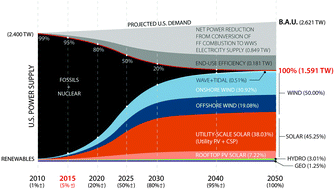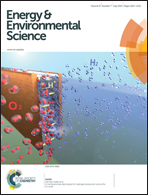100% clean and renewable wind, water, and sunlight (WWS) all-sector energy roadmaps for the 50 United States†
Abstract
This study presents roadmaps for each of the 50 United States to convert their all-purpose energy systems (for electricity, transportation, heating/cooling, and industry) to ones powered entirely by wind, water, and sunlight (WWS). The plans contemplate 80–85% of existing energy replaced by 2030 and 100% replaced by 2050. Conversion would reduce each state's end-use power demand by a mean of ∼39.3% with ∼82.4% of this due to the efficiency of electrification and the rest due to end-use energy efficiency improvements. Year 2050 end-use U.S. all-purpose load would be met with ∼30.9% onshore wind, ∼19.1% offshore wind, ∼30.7% utility-scale photovoltaics (PV), ∼7.2% rooftop PV, ∼7.3% concentrated solar power (CSP) with storage, ∼1.25% geothermal power, ∼0.37% wave power, ∼0.14% tidal power, and ∼3.01% hydroelectric power. Based on a parallel grid integration study, an additional 4.4% and 7.2% of power beyond that needed for annual loads would be supplied by CSP with storage and solar thermal for heat, respectively, for peaking and grid stability. Over all 50 states, converting would provide ∼3.9 million 40-year construction jobs and ∼2.0 million 40-year operation jobs for the energy facilities alone, the sum of which would outweigh the ∼3.9 million jobs lost in the conventional energy sector. Converting would also eliminate ∼62 000 (19 000–115 000) U.S. air pollution premature mortalities per year today and ∼46 000 (12 000–104 000) in 2050, avoiding ∼$600 ($85–$2400) bil. per year (2013 dollars) in 2050, equivalent to ∼3.6 (0.5–14.3) percent of the 2014 U.S. gross domestic product. Converting would further eliminate ∼$3.3 (1.9–7.1) tril. per year in 2050 global warming costs to the world due to U.S. emissions. These plans will result in each person in the U.S. in 2050 saving ∼$260 (190–320) per year in energy costs ($2013 dollars) and U.S. health and global climate costs per person decreasing by ∼$1500 (210–6000) per year and ∼$8300 (4700–17 600) per year, respectively. The new footprint over land required will be ∼0.42% of U.S. land. The spacing area between wind turbines, which can be used for multiple purposes, will be ∼1.6% of U.S. land. Thus, 100% conversions are technically and economically feasible with little downside. These roadmaps may therefore reduce social and political barriers to implementing clean-energy policies.


 Please wait while we load your content...
Please wait while we load your content...